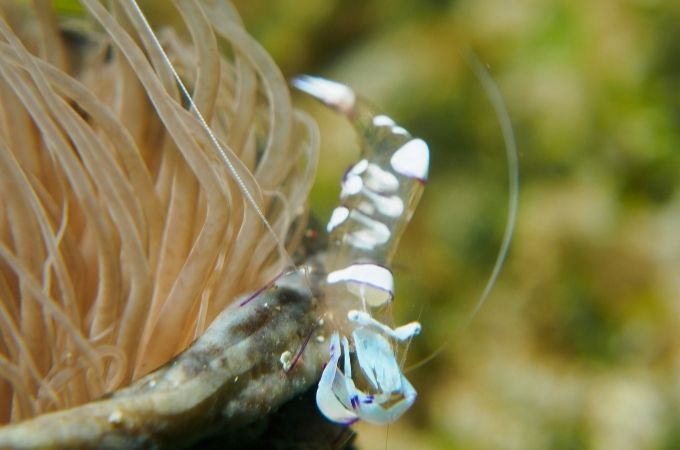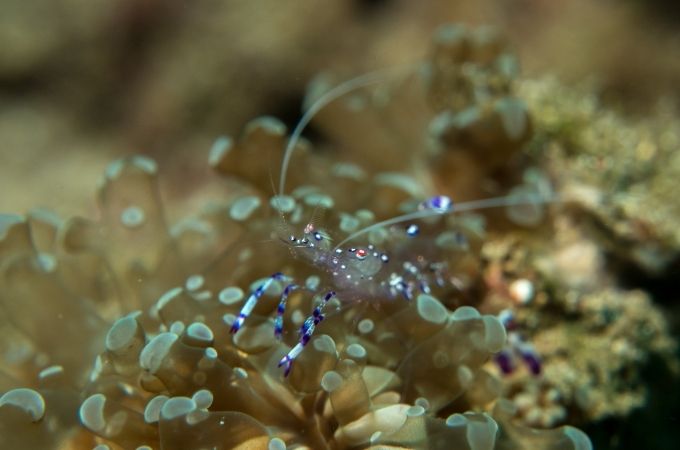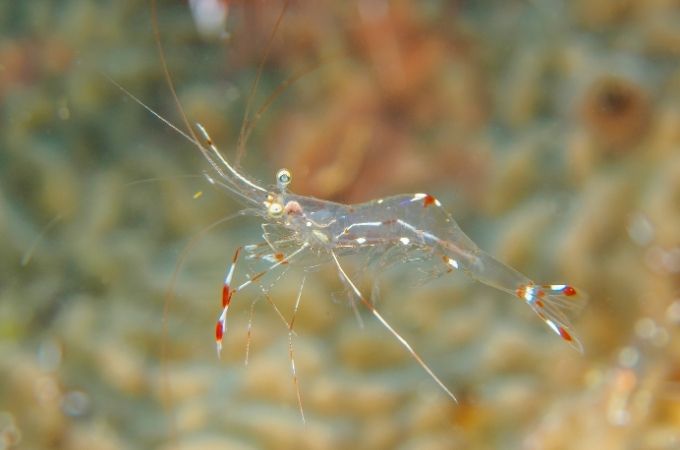Ghost shrimp serve three distinct purposes: cleaners, feeders, and inexpensive shrimp for a shrimp tank.
Whether you’re looking for a cheap feeder or trying to add a fun cleaner to your aquarium, this guide should offer all you need to care for Ghost Shrimp.
Ghost Shrimp Facts
Appearance
As their name suggests, ghost shrimp are “clear” to help them avoid predators. Their translucence would make them hard to spot in an aquarium, but you can see them swimming around due to their active nature.
Although transparent, you can often find a sprinkling of green, or sometimes yellow, dots across their body. These sometimes turn grey and they’re more apparent in some shrimp than others.
Ghost shrimp are similar to larger shrimp in appearance, although their transparent bodies allow you to see inside their bodies. They have an exoskeleton around the outside of their body, which acts as the first line of defense for their soft insides.
They have a rostrum on the front of their face, similar to a nose, and two antennae. The antennae are used for chemical and sensory detection. Ghost Shrimp reach an average of 1.5 inches, with females usually ½ an inch longer than males. Males also have thinner bodies than females.

Behavior
Ghost Shrimp spend most of their time scavenging and cleaning. They can be found swimming around the tank and occasionally interacting with other shrimp. Little is known about their interactions, though they can be aggressive towards one another on occasion.
Besides the occasional skirmish, Ghost Shrimp are incredibly docile. They spend most of their time grazing off plants and cleaning algae off the walls of your aquarium. They are also known to burrow, so don’t be alarmed if you notice them spending time on the substrate or digging.
Lifespan
Ghost Shrimp are not for the easily attached; they only live up to a year. It is not uncommon for Ghost Shrimp to enter new aquariums and die a couple of days after arrival for no apparent reason. Their short lifespans should be taken into account when caring for Ghost Shrimp.
Molting
Ghost Shrimp will molt often depending on how much they eat and how much more room they have for growth. They shed their exoskeleton to grow, which leads to them being unprotected by their outer shell for a couple of days. It is not uncommon to find your shrimp still or hiding right before they molt.
After a molt, they’re vulnerable to fish in your aquarium. Make sure to offer plenty of hiding spots for the shrimp, such as caves, grass, moss, etc. These areas will allow your shrimp a safe place to heal after their molt. Their molts look like an entire shrimp (to varying degrees) but limp. New aquarists sometimes mistake the molt for a dead shrimp, but no need to worry. Molting is natural.
Leave the molt in your aquarium. The shrimp or other fish in the tank will eat the molt. The shed exoskeleton offers nutrition.
It is not uncommon to see cannibalism among shrimp. A common misunderstanding is that a shrimp attacked and ate the other shrimp. More often than not, the shrimp was already dead before the other shrimp decided to eat the dead tankmate. As morbid as this might seem, shrimp are scavengers.

Diet
Consider Ghost Shrimp opportunistic feeders. They’ll eat anything and everything put in front of them, similar to my husband. The majority of their diet should be plant-based. In a well-stocked plant tank, they should have plenty to graze and feed off. You might notice them picking through algae in the substrate and walls of their aquarium.
Since their diet is largely vegetation, regularly feeding your Ghost Shrimp is not a significant concern. Unlike fish that you might feed once or even multiple times a day, you can easily feed a Ghost Shrimp once or twice a week.
When feeding Ghost Shrimp, be careful not to leave food in the aquarium. If shrimp are no longer actively feeding on a pellet or wafer, remove the food immediately. Food left unattended in tanks can quickly lead to poor water quality.
Your Ghost Shrimp will eat off just about any fish food you introduce to the tank. Here are some foods that are excellent for Ghost Shrimp
- Bloodworms
- Flakes
- Algae Wafers
- Almond Leaves
- Spirulina
- Blanched Spinach (excellent source of calcium)
One nutrient that Ghost Shrimp need is calcium. They can receive this from their food or nutrient mineralization. Calcium allows their shells to grow strong and is found naturally in water sources.
Calcium Carbonate is in 30-50% of your shrimp’s exoskeleton or their “shell.” You might notice issues with molting or cracks in their shell if calcium is not available.
The good news is that adding calcium to their water or diet is simple. There are plenty of options. Just make sure to dose slowly and carefully if adding minerals to the water. Oftentimes tricks that raise calcium also raise pH as well, so monitor progress and start slow.
A couple of ways to raise calcium levels in aquariums are
- Calcium Carbonate
- Food treated with extra calcium.
- Shrimp mineral additives
- Antacid tablets
- Mineral calcium blocks
- Shrimp King Mineral (the only one I have personally used)
- Veggie Sticks with calcium
- Cuttle Bones
- Oyster Shells
I would suggest starting with food such as blanched spinach or food with added protein are a remineralizer. The other methods do work but tend to bring other water quality parameters out of balance quickly, especially in smaller tanks.
Breeding
When breeding, make sure to have your male and female shrimp. Male shrimp are smaller with a curved abdomen and females have a broader abdomen and are just larger overall.
The female will release pheromones after a molt when she is ready to breed. This will signal the male to fertilize her eggs. When you notice 20-30 green dots or eggs on the bottom of her abdomen, allow approximately a week, it should take 2-3 days for the male to fertilize her eggs. Afterward, she can move to a breeder tank, where it will be safer for newborn shrimp.
After the time has passed, remove the male and keep the female in the smaller tank. In this tank, all you need is a sponge filter attached to an air pump, a lid, a dim light, a fine substrate, and a couple of plants for the newly born shrimp to hide in.
The female should hatch her eggs in 12-14 days. Unlike many dwarf shrimp species, these shrimp have a larval stage and will not look like a miniature version of their parents. As soon as you notice her eggs are gone, remove the mother back to the main tank.
To feed the larval shrimp, you will need a syringe and powdered foods. Spirulina, zooplankton, and artemia will make excellent food. Make sure to swirl it in their water and into the tank. The larval shrimp will hang out near the top of the tank, and the syringed food can be spread across the top of your tank. You can feed the baby shrimp twice a day, approximately 50-100mL of food. Try not to pollute the water and keep the food spaced out across the tank.
Once your shrimp look like shrimp or go through metamorphosis, you can feed them normal foods. Five weeks after hatching, your shrimp should be large enough to reintroduce to the main tank. If you’re unsure, add one and see how the young shrimp generally does. If they can fit in any of their tankmates’ mouths, don’t add them yet.
Use as Feeders
Ghost Shrimp are often used to feed other pets. This is due to their abundance in the fish community and their low cost. Another benefit to keeping Ghost Shrimp as feeders is they do not carry ich and will not introduce ich to the aquarium.
But Ghost Shrimp do carry nematodes, which are often found not to affect the fish consuming the Ghost Shrimp.
Any fish with a large enough mouth might benefit from eating Ghost Shrimp. These include Goldfish, Gouramis, Cichlids, etc. This should not make up most of their diet due to their lack of nutritional value, but can be given as a treat or enrichment to your larger pet fish.

Setting up your Ghost Shrimp Habitat
Aquarium Tank Size
5 gallons is the minimum size and should allow you room for 2-5 shrimp per gallon. Dwarf shrimp have a small bioload and are safe to keep in smaller aquariums.
If you are keeping Ghost Shrimp as feeders, you can keep more shrimp per gallon.
Type of Substrate
The best substrate for Ghost Shrimp is a fine substrate. Their heads are sensitive and they like to burrow, so heavier substrates aren’t ideal for them.
Fine substrates also work well for plants, just add some tabbed fertilizers or liquid fertilizers, and your plants will do well despite not using a particular plant substrate.
Filtration
Ghost Shrimp are not heavy waste producers. That’s why you can keep more shrimp in a smaller area than you would fish. Since they do not produce a heavy amount of waste, the filtration needs are minimal.
You can purchase a shrimp-specific filter, which will be low flow and safer for shrimp that might be sucked into the filter. However, I recommend looking closely at the reviews of any shrimp filter you’re considering buying. Some models just don’t work very well.
I keep shrimp and I prefer sponge filters. The mechanism is a simple sponge filter attached to an air stone and air pump. It holds bacteria that cleans the water and helps oxygenate it as well. They’re ideal for smaller shrimp tanks (less than 29 gallons) and it’s virtually impossible for them to harm your shrimp.
Lighting
Ghost Shrimp are not particular about their lighting. If you have plants that require high lighting, you can buy a light specifically for aquarium plants’ needs. Most shrimp feel safer with hiding areas provided by healthy plants.
Plants and Decorations
Decorations are neither essential nor detrimental to a Ghost Shrimp tank. If you would like to add decorations for aesthetics, by all means, add decorations.
On the other hand, plants are definitely necessary additions to Ghost Shrimp tanks. They provide food, shelter, and plants help improve water quality. They also help reduce toxic compounds such as ammonia and phosphate.
The reduction of phosphate, in turn, also reduces the amount of excess algae found in the tank.
Plants are helpful to the overall health of your aquarium. Some good plants to keep in your Ghost Shrimp tank include:
- Wisteria
- Lilies
- Pennywort
- Hornwort
- Anubis
- Java Moss
- Java Fern
- Moss Balls
Many other plants will work in your aquarium as well, just make sure they are safe for inhabited aquariums and all proper water quality parameters are met.
Tankmates
Be careful with Ghost Shrimp tankmates. Many fish see Ghost Shrimp as a quick snack. A rule of thumb is not to introduce any fish that could fit a shrimp in their mouth or any aggressive species of fish.
Tankmates you can keep with Ghost Shrimp include.
- Zebra Loaches
- Khuli Loaches
- Small nonagressive Tetras
- Amano Shrimp
- Vampire Shrimp
- Bamboo Shrimp
- Cory Catfish
- Otocinclus Catfish
- Cherry Barbs
- Danios
- Snails
Brackish
It’s a common myth that Ghost Shrimp need brackish water or “do better” in brackish water. They can survive in brackish water but do not live longer than they would in freshwater or water less than 5ppt.
Another popular myth is that Ghost Shrimp need brackish water to breed. On the contrary, the higher the salinity, the fewer eggs will hatch. So, although you can keep a mild salinity in your
Ghost Shrimp aquarium, it is not necessary or ideal.

Tank Environment for Ghost Shrimp
Water Temperature
Ghost Shrimp can tolerate a wide range of temperatures from 65-82 degrees Fahrenheit. However, they prefer stability in their water conditions, so your tank should only differ between one to two degrees in 24 hours.
Temperatures over 75 degrees Fahrenheit are more likely to induce breeding.
Water Flow
High water flow can be an issue for Ghost Shrimp. They are not the best swimmers and will struggle if the flow is too high; if you notice your shrimp struggling to swim, adjust the flow by adding a sponge to your output or consider getting a different filtration device.
pH
Ghost Shrimp prefer a higher pH from 7.0-8.0. This is usually easy to maintain if you are using tap water.
Chlorine and Chloramines
Chlorine and chloramines can be removed by water by either buying pretreated RO (reverse osmosis) or DI (deionized) water or by purchasing your own RO or DI unit. If you are buying your unit, make sure to routinely clean and replace parts in the unit; otherwise, contaminants and chlorine are still likely to invade your water supply.
Water conditioner also removes chlorine and chloramines from your tap water. Simply read the directions and dose appropriately each time you perform a water change.
Ammonia, Nitrite, and Nitrate
Ammonia and nitrite values should be kept at zero. If you notice an introduction of ammonia or nitrite in your water quality, conduct a 25% water change and add starter bacteria to your aquarium. This will help the aquarium cycle quicker and prevent the loss of your fish.
Nitrate should ideally stay below 10ppm. This is easy to do as long as the tank is not overcrowded and the aquarium is not overfed. The more plants you keep in the aquarium, the less likely you should have to deal with excessive nitrates.
If your nitrates go above 10ppm, perform two water changes per week. Shrimp will not tolerate much more than that, although you can perform a water change every other day in extreme circumstances. Do not remove more than 25% of the water at once.
Here are some critical points in cycling and maintaining a cycled tank
- Add starter bacteria if ammonia and nitrite are present.
- Do not clean your sponge or filter media the same day you perform a water change.
- Perform one 15-20% water change once a week.
- Clean filter media every 3-6 weeks.
- Do not add all your fish at the same time.
- Remove uneaten food.
- Do not overfeed.
Hardness
Ghost Shrimp prefer hard water between 5-8 GH (general hardness); this should be easy to reach when using tap water or with the addition of a calcium supplement.
Although Ghost Shrimp prefer 5-8 GH, they will tolerate anywhere from 3-15 GH. Therefore, general hardness in their water quality is not anything to lose sleep over.
Copper
Very important, do not use copper treatments for any invertebrates. Copper is often used to treat disease in fish but it is lethal to invertebrates, such as your Ghost Shrimp.

Common Challenges with Ghost Shrimp and Treatments
Jumping
Ghost Shrimp are known for jumping out of their aquariums. Be careful to keep lids on at all times, including while doing water changes.
If your Ghost Shrimp does jump out of your tank, gently pick it up and set it in the water. Be careful not to pull at any of their appendages and observe for any issues.
Vorticella
Vorticella looks like a white spongey fungus found at the tip of your shrimp’s nose (rostrum). Vorticella is a parasite brought in by other animals, plants, and driftwood pieces.
API primafix and saltwater baths are a great way to treat Vorticella. If you notice the Vorticella remove the shrimp to a quarantine tank, treat it with API primafix and use aquarium salt. Vorticella can be lethal but might also pass with well-kept water quality.
Bacterial Infections
Bacterial infections are hard to detect in shrimp. If you notice a change in organ color, it might be a sign of a bacterial infection. Bacterial infections are often caused by poor water quality.
Remove your shrimp and place it in a quarantine tank. This might be all the shrimp needs. Otherwise, you can dose 1mL of Hydrogen Peroxide per 4L of water to try and remove the infection.
Fungal Infections
Fungal infections are easier to spot and look similar to fungal infections in fish: white, puffy, and similar in texture to a cotton ball. Fungal infections are likely to be caused by poor water quality as well.
You can separate your infected shrimp to a quarantine tank. Then treat the water with an anti-fungal, careful to read over ingredients in your anti-fungal not to introduce copper.

Final Word
Ghost Shrimp are fun and easy to care for aquarium pets.
If you’re considering adding them to your tank, just follow this guide and I’m confident that you’ll be satisfied with how happy and healthy you’ll find your shrimp to be!
More Care Guides:
